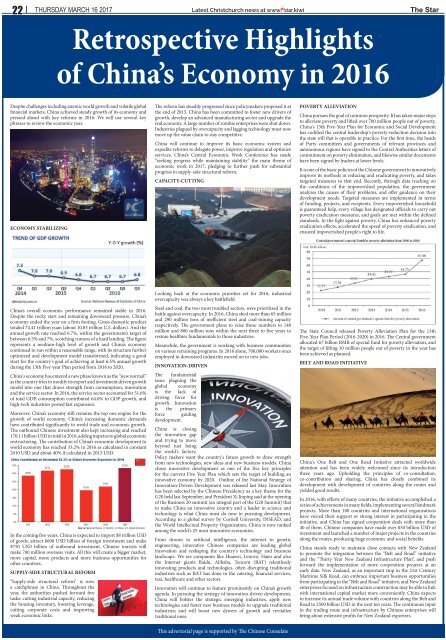117075cs
You also want an ePaper? Increase the reach of your titles
YUMPU automatically turns print PDFs into web optimized ePapers that Google loves.
22 Thursday March 16 2017<br />
Latest Christchurch news at www. .kiwi<br />
The Star<br />
Retrospective Highlights<br />
of China’s Economy in 2016<br />
Despite challenges including anemic world growth and volatile global<br />
financial markets, China achieved steady growth of its economy and<br />
pressed ahead with key reforms in 2016. We will use several key<br />
phrases to review the economic year.<br />
ECONOMY STABILIZING<br />
The reform has steadily progressed since policymakers proposed it at<br />
the end of 2015. China has been committed to foster new drivers of<br />
growth, develop an advanced manufacturing sector and upgrade the<br />
real economy. A large number of zombie enterprises were shut down.<br />
Industries plagued by overcapacity and lagging technology must now<br />
move up the value chain to stay competitive.<br />
China will continue to improve its basic economic system and<br />
expedite reforms to delegate power, improve regulation and optimize<br />
services. China’s Central Economic Work Conference has made<br />
“seeking progress while maintaining stability” the main theme of<br />
economic work in 2017, pledging to further push for substantial<br />
progress in supply-side structural reform.<br />
CAPACITY-CUTTING<br />
POVERTY ALLEVIATION<br />
China pursues the goal of common prosperity. It has taken major steps<br />
to alleviate poverty and lifted over 700 million people out of poverty.<br />
China's 13th Five-Year Plan for Economic and Social Development<br />
has codified the central leadership's poverty-reduction decision into<br />
the state will that is operable in practice. For the first time, the heads<br />
of Party committees and governments of relevant provinces and<br />
autonomous regions have signed to the Central Authorities letters of<br />
commitment on poverty elimination, and likewise similar documents<br />
have been signed by leaders at lower levels.<br />
It is one of the basic policies of the Chinese government to innovatively<br />
improve its methods in reducing and eradicating poverty, and takes<br />
targeted measures to that end. Recently, through data tracking on<br />
the conditions of the impoverished population, the government<br />
analyzes the causes of their problems, and offer guidance on their<br />
development needs. Targeted measures are implemented in terms<br />
of funding, projects, and recipients. Every impoverished household<br />
is guaranteed help, every village has designated officials to carry out<br />
poverty eradication measures, and goals are met within the defined<br />
standards. In the fight against poverty, China has enhanced poverty<br />
eradication effects, accelerated the speed of poverty eradication, and<br />
ensured impoverished people's right to life.<br />
China’s overall economic performance remained stable in 2016.<br />
Despite the rocky start and remaining downward pressure, China’s<br />
economy ended the year on a firm footing. Gross domestic product<br />
totaled 74.41 trillion yuan (about 10.83 trillion U.S. dollars). And the<br />
annual growth rate reached 6.7%, within the government’s target of<br />
between 6.5% and 7%, scotching rumors of a hard landing. The figure<br />
represents a medium-high level of growth and China’s economy<br />
continued to run within a reasonable range, with its structure further<br />
optimized and development model transformed, indicating a good<br />
start for the country's goal of achieving at least 6.5% annual growth<br />
during the 13th Five-year Plan period from 2016 to 2020.<br />
China's economy has entered a new phase known as the “new normal”<br />
as the country tries to modify its export and investment driven growth<br />
model into one that draws strength from consumption, innovation<br />
and the service sector. In 2016, the service sector accounted for 51.6%<br />
of total GDP, consumption contributed 64.6% to GDP growth, and<br />
high-tech industries posted fast expansion.<br />
Moreover, China’s economy still remains the top one engine for the<br />
growth of world economy. China’s increasing domestic demands<br />
have contributed significantly to world trade and economic growth.<br />
The outbound Chinese investment also kept increasing and reached<br />
170.11 billion USD in total in 2016, adding impetus to global economic<br />
restructuring. The contribution of China’s economic development to<br />
world economy has reached 33.2% in 2016 as calculated in constant<br />
2010 USD and about 40% if calculated in 2015 USD.<br />
In the coming five years, China is expected to import $8 trillion USD<br />
of goods, attract $600 USD billion of foreign investment and make<br />
$750 USD billion of outbound investment. Chinese tourists will<br />
make 700 million overseas visits. All this will create a bigger market,<br />
more capital, more products and more business opportunities for<br />
other countries.<br />
SUPPLY-SIDE STRUCTURAL REFORM<br />
“Supply-side structural reform” is now<br />
a catchphrase in China. Throughout the<br />
year, the authorities pushed forward five<br />
tasks: cutting industrial capacity, reducing<br />
the housing inventory, lowering leverage,<br />
cutting corporate costs and improving<br />
weak economic links.<br />
Looking back at the economic priorities set for 2016, industrial<br />
overcapacity was always a key battlefield.<br />
Steel and coal, the two most troubled sectors, were prioritized in the<br />
battle against overcapacity. In 2016, China shed more than 65 million<br />
and 290 million tons of inefficient steel and coal-mining capacity<br />
respectively. The government plans to raise those numbers to 140<br />
million and 800 million tons within the next three to five years to<br />
restore healthier fundamentals to those industries.<br />
Meanwhile, the government is working with business communities<br />
on various retraining programs. In 2016 alone, 700,000 workers once<br />
employed in downsized industries moved on to new jobs.<br />
INNOVATION-DRIVEN<br />
The fundamental<br />
issue plaguing the<br />
global economy<br />
is the lack of<br />
driving force for<br />
growth. Innovation<br />
is the primary<br />
force guiding<br />
development.<br />
China is closing<br />
the innovation gap<br />
and trying to move<br />
beyond just being<br />
the world's factory.<br />
Policy makers want the country's future growth to draw strength<br />
from new technologies, new ideas and new business models. China<br />
chose innovative development as one of the five key principles<br />
for the current Five Year Plan which sets the target of building an<br />
innovative economy by 2020. Outline of the National Strategy of<br />
Innovation-Driven Development was released last May. Innovation<br />
has been selected by the Chinese Presidency as a key theme for the<br />
G20 held last September, and President Xi Jinping said at the opening<br />
of the Business 20 summit (an integral part of the G20 Summit) that<br />
to make China an innovative country and a leader in science and<br />
technology is what China must do now in pursuing development.<br />
According to a global survey by Cornell University, INSEAD, and<br />
the World Intellectual Property Organization, China is now ranked<br />
among the world's 25 most innovative economies.<br />
From drones to artificial intelligence, the internet to genetic<br />
engineering, innovative Chinese companies are leading global<br />
innovation and reshaping the country's technology and business<br />
landscape. We see companies like Huawei, Lenovo, Haier and also<br />
the Internet giants Baidu, Alibaba, Tencent (BAT) relentlessly<br />
innovating products and technologies, often disrupting traditional<br />
industries such as BAT has done in the catering, financial services,<br />
taxi, healthcare and other sectors.<br />
Innovation will continue to feature prominently on China’s growth<br />
agenda. In pursuing the strategy of innovation-driven development,<br />
China will bolster the strategic emerging industries, apply new<br />
technologies and foster new business models to upgrade traditional<br />
industries; and will boost new drivers of growth and revitalize<br />
traditional ones.<br />
The State Council released Poverty Alleviation Plan for the 13th<br />
Five-Year Plan Period (2016-2020) in 2016. The Central government<br />
allocated 67 billion RMB of special fund for poverty alleviation, and<br />
the target of lifting 10 million people out of poverty in the year has<br />
been achieved as planned.<br />
BELT AND ROAD INITIATIVE<br />
China's One Belt and One Road Initiative attracted worldwide<br />
attention and has been widely welcomed since its introduction<br />
three years ago. Upholding the principles of co-consultation,<br />
co-contribution and sharing, China has closely combined its<br />
development with development of countries along the routes and<br />
yielded good results.<br />
In 2016, with efforts of many countries, the initiative accomplished a<br />
series of achievements in many fields, implementing several landmark<br />
projects. More than 100 countries and international organizations<br />
have voiced their support or strong interest in participating in the<br />
initiative, and China has signed cooperation deals with more than<br />
40 of them. Chinese companies have made over $50 billion USD of<br />
investment and launched a number of major projects in the countries<br />
along the routes, producing huge economic and social benefits.<br />
China stands ready to maintain close contacts with New Zealand<br />
to promote the integration between the “Belt and Road” initiative<br />
and the “Thirty Year New Zealand Infrastructure Plan”, and push<br />
forward the implementation of more cooperation projects at an<br />
early date. New Zealand, as an important stop in the 21st Century<br />
Maritime Silk Road, can embrace important business opportunities<br />
from participating in the “Belt and Road” initiative, and New Zealand<br />
enterprises focused on infrastructure construction may be able to link<br />
with international capital market more conveniently. China expects<br />
to increase its annual trade volume with countries along the Belt and<br />
Road to 2500 billion USD in the next ten years. The continuous input<br />
in the trading route and infrastructure by Chinese enterprises will<br />
bring about extensive profits for New Zealand exporters.<br />
This advertorial page is supported by The Chinese Consulate















